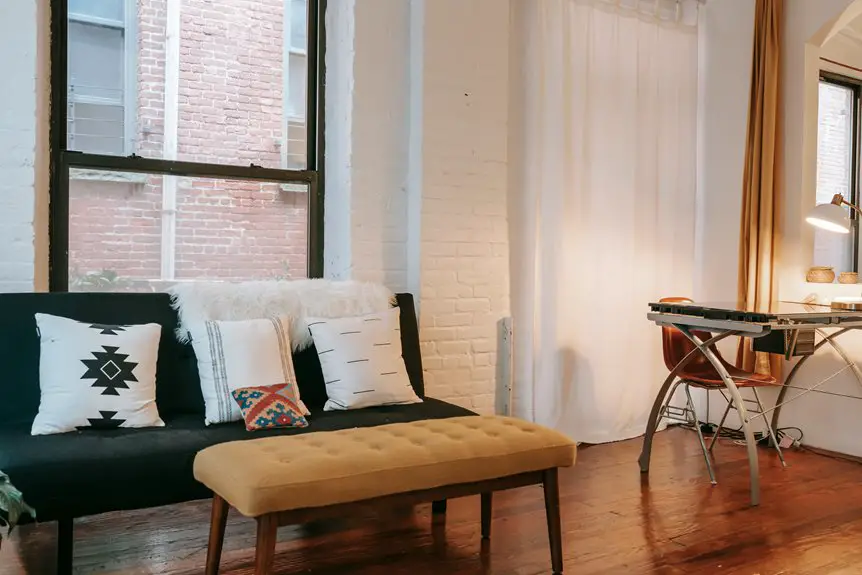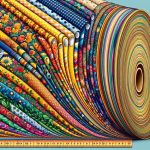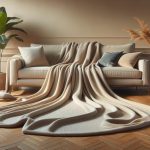You’ll typically need 5 to 9 yards of fabric for chairs, depending on size and style, and 12 to 20 yards for sofas or sectionals, considering cushions and arms. Patterned or textured fabrics require extra yardage—usually 15-30% more—to match designs properly. Make sure to measure your furniture’s height, width, and depth accurately for the best estimate. Keep in mind fabric durability and direction too. If you want to get it just right, knowing the details will help you avoid mistakes.
Table of Contents
Key Takeaways
- Standard armchairs require 5 to 7 yards of fabric; larger or detailed chairs need up to 9 yards.
- Sofas typically need 12 to 16 yards, depending on size and cushion count.
- Add 15-30% more fabric for large, directional, or complex patterns to ensure proper matching.
- Measure height, width, depth, and cushion dimensions to calculate accurate fabric yardage.
- Always round up fabric requirements and include extra for seams, mistakes, and future repairs.
Factors Influencing Fabric Requirements for Upholstery
When you plan your upholstery project, several key factors affect how much fabric you’ll need.
First, consider the size of the furniture—larger pieces naturally require more material.
Next, think about the type of fabric you choose; some patterns or textures need extra fabric to match seams or repeats.
Consider fabric patterns and textures carefully, as matching seams or repeats often requires additional material.
Also, take into account the style of upholstery, like whether your piece has cushions, skirts, or tufting, as these details demand additional yardage.
Don’t forget to factor in fabric orientation, especially if the fabric has a nap or directional pattern.
Finally, allow extra fabric for mistakes or future repairs.
Estimating Fabric Yardage for Different Chair Styles
When reupholstering an armchair, you’ll typically need about 6 to 7 yards of fabric, depending on size and cushion style.
Wingback chairs often require more fabric—around 9 yards—due to their high backs and unique shape.
Knowing these estimates helps you buy the right amount without overspending or coming up short.
Armchair Fabric Requirements
Estimating fabric yardage for armchairs depends largely on the chair’s style and size. For a standard armchair, you’ll typically need between 5 to 7 yards of fabric.
If the chair has more intricate details like tufting or piping, factor in extra yardage to accommodate those features. Larger or overstuffed armchairs might require up to 8 yards.
When measuring, consider the fabric’s pattern repeat, as matching patterns will increase the amount you need. Also, don’t forget to account for seams, cushions, and any removable covers.
To guarantee accuracy, it’s best to consult your chair’s dimensions and add a little extra fabric for mistakes or future repairs. This way, you’ll avoid running short mid-project and keep your upholstery looking seamless.
Wingback Upholstery Measurements
Wingback chairs usually demand more fabric than standard armchairs due to their high backs and extended wings. When estimating fabric yardage, expect to need about 7 to 9 yards, depending on the chair’s size and pattern repeat.
Measure the height from floor to top of the back, the width across the wings, and the seat dimensions. Don’t forget to add extra fabric for matching patterns or tufting if your chair has those details.
Also, consider fabric direction—some fabrics require vertical alignment, increasing fabric needs. If your wingback includes a skirt, add extra yardage accordingly.
Calculating Fabric Needs for Sofas and Sectionals
To calculate fabric needs for your sofa or sectional, start by measuring its length, width, and height carefully.
Keep in mind that the type of fabric and any patterns will affect how much material you’ll need.
With accurate measurements and fabric details, you can estimate the yardage more precisely.
Measuring Sofa Dimensions
Measuring your sofa accurately is the first step to knowing how much fabric you’ll need for upholstery. Start by measuring the length of the sofa from arm to arm, then measure the height from the base to the top of the backrest.
Don’t forget to include the depth, which is the distance from the front edge to the back cushion. Measure each arm separately, especially if they differ in size.
Also, take note of any unique features like cushions, skirts, or tufting. Use a tape measure and jot down every dimension clearly.
These precise measurements guarantee you buy enough fabric to cover every part without running short. Getting this right saves time and prevents costly mistakes later in your upholstery project.
Fabric Yardage Estimation
Once you have your sofa’s dimensions, you can calculate how much fabric you’ll need for your upholstery project. Start by adding the length, width, and height of the sofa to estimate the total surface area.
Don’t forget to include cushions, arms, and any skirt or additional features. Multiply this combined measurement by a factor to allow for seams, tucks, and pattern matching, usually around 1.5 to 2 times the base amount.
For sectionals, measure each section separately, then add those yardages together. It’s wise to round up to the nearest half or full yard to avoid shortages.
Keep in mind, fabric width varies, so check your fabric’s width when converting measurements to yards. This guarantees you buy the right amount without overspending or running short.
Pattern and Fabric Type
Choosing the right pattern and fabric type considerably impacts how much material you’ll need for upholstering sofas and sectionals.
If you select a fabric with a large or directional pattern, expect to buy extra yardage to match designs across seams and cushions. This often means adding 15-30% more fabric than a plain or small-scale pattern requires.
Additionally, fabric types like velvet or corduroy demand more careful cutting to maintain pile direction, which can increase waste.
On the other hand, fabrics with irregular or non-directional patterns let you use yardage more efficiently.
Keep in mind that heavier or textured fabrics sometimes require more precision and, consequently, more fabric to avoid mismatched areas.
Always consult your fabric supplier for specific recommendations based on your upholstery project.
Tips for Choosing the Right Upholstery Fabric
How do you pick the perfect fabric that balances durability, style, and comfort? Start by considering your lifestyle—if you have kids or pets, choose a fabric that’s tough and easy to clean, like microfiber or leather.
Next, think about the room’s style and color palette to guarantee your fabric complements the space. Don’t forget texture; a soft, breathable fabric feels inviting, while a sleek, smooth one offers a modern vibe.
Check the fabric’s rub count too; higher counts mean better durability. Finally, request fabric samples to see how they look and feel in your home’s lighting before making a decision.
How to Measure Your Furniture Accurately
Before you buy fabric, you’ll need to measure your furniture carefully to guarantee you get the right amount. Start by measuring the height, width, and depth of each section you plan to upholster—arms, back, seat, and cushions.
Use a flexible tape measure to follow curves and contours accurately. Don’t forget to add extra inches for seams, tucking, and pattern matching. Measure twice to avoid errors, and write down each number clearly.
If your piece has removable cushions, measure them separately. For sofas, measure the overall length and height, then break it down into individual parts.
Accurate measurements prevent ordering too little or too much fabric, saving you time and money on your upholstery project.
Common Mistakes to Avoid When Buying Upholstery Fabric
Getting your measurements right is only part of the process; selecting the wrong fabric can still derail your upholstery project. You want fabric that’s durable, fits your style, and works with your furniture’s shape.
Avoid these common mistakes:
- Choosing fabric solely by color without checking texture or durability.
- Ignoring the fabric’s rub count, which indicates how well it withstands wear.
- Forgetting to evaluate fabric pattern direction or repeat size, which affects yardage and final appearance.
- Overlooking fabric care requirements—some materials need special cleaning that mightn’t suit your lifestyle.
Frequently Asked Questions
What Tools Do I Need for Reupholstering Furniture at Home?
You’ll want some trusty companions like a staple remover, scissors, fabric glue, and a sewing kit. Don’t forget a screwdriver and pliers—they’ll gently help you give your furniture a fresh, charming new outfit with ease.
How Do I Remove Old Fabric From a Chair or Sofa?
You’ll start by carefully removing staples or tacks with a staple remover or pliers. Then, gently peel off the old fabric, working slowly to avoid damaging the padding or frame beneath.
Can I Upholster Furniture Without Sewing Skills?
You can absolutely upholster furniture without sewing skills! Use staple guns, fabric glue, or no-sew adhesive tape to attach fabric. Just measure carefully, cut precisely, and secure fabric tightly for a neat, professional look.
What Type of Padding Is Best for Upholstery Projects?
Padding perfection primarily points to polyurethane foam; it provides plush, durable comfort. You’ll want to weigh wool or cotton batting for softness. Don’t discount dense dacron wrap—it delivers delightful, decorative depth. Choose wisely!
How Long Does a Typical Upholstery Project Take to Complete?
You’ll usually spend a weekend on a typical upholstery project, around 8-12 hours. Complex pieces may take longer. Taking your time guarantees quality, so don’t rush—you’ll appreciate the results more.







